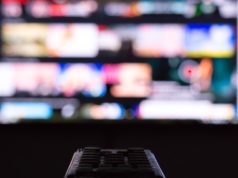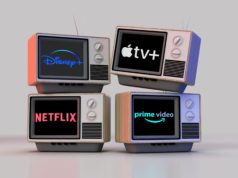 Microsoft chief operating officer Steve Ballmer used his Jan. 9 keynote at 2012 International CES to lay out the company’s vision for Xbox 360, Kinect and Xbox Live as the core of every household’s entertainment system, the promise of Windows Phones, and the next version of Windows as a unified platform that brings it all together regardless of device or screen in a way that puts people first.
Microsoft chief operating officer Steve Ballmer used his Jan. 9 keynote at 2012 International CES to lay out the company’s vision for Xbox 360, Kinect and Xbox Live as the core of every household’s entertainment system, the promise of Windows Phones, and the next version of Windows as a unified platform that brings it all together regardless of device or screen in a way that puts people first.
Ryan Seacrest, the evening’s host and emcee, led Ballmer in question and answer session that covered all that plus Kinect for Windows, Windows 8 and other aspects of Microsoft’s plans for the near future.
What follows is a condensed transcript of what they said.
RYAN SEACREST: What can we expect? What should we be looking for this evening?
STEVE BALLMER: Tonight, I think we’ve got a really tremendous show, frankly. We have a chance in the next year to really raise our game, our product line to the next level, across phones, PCs, tablets, TV, the Xbox, and really the heart and soul of that will be our kind of featured attraction tonight, our new Metro user interface. We kind of pioneered it over the last few years, but you’ll see it tonight, fast, fluid, and dynamic across all the Microsoft experiences, and really helping people to connect directly to the people and information, music, friends that are most important to them. I think will be kind of impressed on how it lights everything up.
RYAN SEACREST: I like that. When you said Metro you looked at me in a strange way, or I thought. Is it the jacket, or the sweater, or the combination?
STEVE BALLMER: I was going to say it’s a new design and a new year, but you take it from there, for Microsoft and Ryan.
RYAN SEACREST: I’m your mascot. All right, so it’s going to be a fun night. Let’s start with Windows Phone. Definitely different.
STEVE BALLMER: I’m really excited and upbeat about where we are. We definitely took a different approach than everybody else, and I think we’ve got a really unique and beneficial experience. All these phones these days, they all make calls, connection to the Internet, email, social networks, blah, blah, blah, blah, blah. If you take a look at it, the other phones all make the sea of icons, the sea of applications the kind of view of the world. But what happens is, things change. Now, people tweet, they post, they email, they text. It all gets put together right there for you, right on the screen. What’s important to you isn’t lighting up emails, or lighting up the text, it’s what’s going on with brother, sister, co-worker, your Twitter feed, whatever the case may be.
And literally, in my own case, I’m in regular touch with hundreds of people, and yet I get it consolidated down to where at a glance I can really see what’s going on.
RYAN SEACREST: So, tell us what’s going on with the phone’s hardware partners?
STEVE BALLMER: We really have an incredible amount of work going on with some really innovative companies. With Samsung, with HTC, with LG, and with Nokia, the range and diversity of devices is amazing. And the quality of work is special.
About a year ago, we announced a partnership with Nokia. They’ve already delivered Windows Phone around the world, but really now intending to go bigger here in North America this year. And I’m pleased to announce that the Nokia Lumia 710 and Lumia 800 will be coming soon to consumers in Canada on the Rogers and TELUS network. And this Wednesday, here in the U.S., T-Mobile customers can buy the Lumia 710, Nokia’s first Windows Phone in the United States. The popular Nokia Lumia 800 Windows Phone will also be available in the growing base of Microsoft physical stores, unlocked here in the next few months.
But the thing I’m really kind of pumped up about actually is the work that’s going on on moving to 4G LTE networks. And today we had a chance with Nokia and AT&T to unveil the Nokia Lumia 900. It’s really an incredible phone. It’s blazing fast on the AT&T network. It’s got this 4.3 inch AMOLED Clear Black display, and it will be heavily promoted in all 2,400 of AT&T stores here in the U.S. in the next few months.
RYAN SEACREST: Beautiful.
STEVE BALLMER: Good move there. But wait, right, how does that line go?
RYAN SEACREST: But wait, there’s more?
STEVE BALLMER: But wait, there’s more. Let me show you a new phone today.
This is the new HTC Titan II. This is the HTC Titan II. HTC is an incredibly innovative company. This product was also launched today. It will be available on AT&T’s 4G LTE network. It’s an even bigger 4.7-inch super LCD screen. And, amazingly, it’s got a 16-megapixel camera built in which is higher resolution than almost everybody has on their digital cameras today. With new 4G LTE phones, a design, frankly, that’s winning rave reviews. Over 50,000 applications already published in our marketplace, and that’s growing about 300 a day. I think with the Windows Phone, Ryan, we’re clearly on the right track.
RYAN SEACREST: So, there is obviously so much going on in the mobile market right now, it will be an interesting year, and we’ll certainly be looking to see what happens with Windows Phone Next. So, thank you very much.
Next product, let’s go to the area and focus on Windows PCs. So, things are changing quite rapidly and you guys, you have some tough competition. Let’s talk about it.
STEVE BALLMER: Nothing better than good competition; nothing better than good competition. It’s a great thing and I’m glad we’ve got Windows. Windows has been phenomenal. The product, the technology, the market acceptance, the brand, and in a sense one of the most amazing phenomenon in our business, whether you go back to that first CES keynote, or further back, has been the way that the Windows PC has constantly changed and reinvented, and moved forward, and spurred other technology innovations. Today over 1.3 billion Windows PCs are in use around the planet. That makes it the most popular smart device around.
RYAN SEACREST: Amazing demos, amazing machines.
STEVE BALLMER: You know, Windows 7 is the best-selling operating system of all time. Five hundred million users on the planet for Windows 7. We’re licensing about seven new copies a second. And by my calculation, I think that means by the time we wrap up today, there are probably 25,000 new Windows 7 users on this planet. That’s pretty good, dude.
RYAN SEACREST: And all those PCs up there will run Windows 8?
STEVE BALLMER: Every Windows 7 PC will be ready for Windows 8 on day one. So, the 3 million people who have already come to our website and downloaded the Windows 8 preview, boom, they can do it from any Windows PC ever made.
RYAN SEACREST: Pretty exciting. And, we’ve covered a lot so far. So, let’s keep moving. Ten years ago, Steve, if I were to walk up to somebody on the street and say “Xbox” to them, they would probably give me a blank stare. But now Xbox is at the forefront of games and entertainment. Did you expect to go from ground zero to a household name when you set out to do this a decade ago?
STEVE BALLMER: I was optimistic. I was bullish. I was patient. All of the above. In a sense, Xbox kind of represents the best of a part of our DNA that we’re really proud about. We make these big, bold bets. We invest for the long-term. And we make exciting things happen. And we’re 10 years later, we’re the world’s sales leader in the last year for consoles, which is exciting as heck. We have over 66 million Xbox users. And perhaps the most amazing thing is, we have over 40 million Xbox Live subscribers tuning in on a regular basis for a variety of different entertainment experiences. Some for games, mostly in the last year or so for a lot of family entertainment, and increasingly in the last months, and with something I’d like to show you today, really an entertainment hub for live TV, on demand, videos, movies, news, social, music, and of course still games. But morphing, changing.
So, did I expect it 10 years ago? No. But I bet on it 10 years ago, and I’m excited about that.
RYAN SEACREST: Let’s take a look at what people are sort of drumming up right now, shall we?
STEVE BALLMER: Tonight, I’m thrilled to announce that Kinect is coming to Windows on February 1st, in just a couple of weeks. We’re already working with more than 200 companies on unique Kinect for Windows applications. The breadth of what they’re doing is mind-blowing from United Health Group, Toyota, Telefonica, Mattel, American Express, and many, many more.
RYAN SEACREST: So, one final question on your final keynote event this evening: What’s next?
STEVE BALLMER: What’s next?
RYAN SEACREST: You know something we don’t know.
STEVE BALLMER: Windows 8 is what’s next. The next milestone is in late February and then boom, on to the shipment of Windows 8. There’s nothing more important at Microsoft than Windows, and delivering the kind of no-compromise experience with the dynamic Metro user interface.
You saw Metro in the phone, you saw Metro in Windows, you saw Metro in Xbox. It’s everywhere: tablets, PCs, phones, TV, and Xbox. And you’ll experience more and more natural user interface through Metro, as we had a chance to see in the Kinect demonstration.
Together, all of us in this industry in thousands of new ways, even new ways that we haven’t imagined yet, we’ll use the software and services and devices to invent incredible things.
Metro will drive the new magic across all of our user experiences. In the new math at Microsoft Metro means that one plus one really does equal three.
So, in 2012 what’s next? Metro, Metro, Metro – and of course, Windows, Windows, Windows.
RYAN SEACREST: Well said. And by the way, I think that is the perfect spot to end right there, with that conviction and passion.








It’s painful to listen to Ballmer talk. Who is an industry leader and says “blah, blah, blah, blah, blah” (literally 5 ‘blah’s in a row) and says “wait! there’s more!” like a late night cheap commercial.